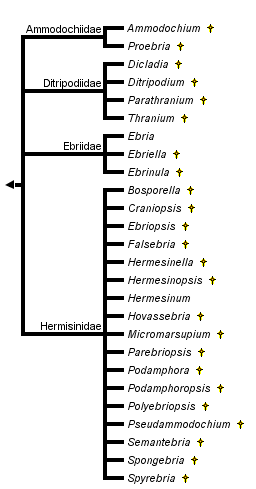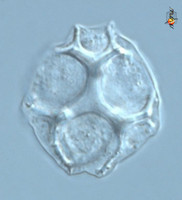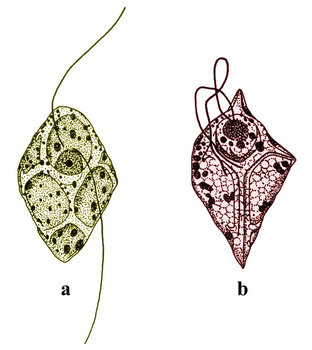Ebriida
ebriids, Ebriidae
Chitchai Chantangsi and Brian S. Leander


This tree diagram shows the relationships between several groups of organisms.
The root of the current tree connects the organisms featured in this tree to their containing group and the rest of the Tree of Life. The basal branching point in the tree represents the ancestor of the other groups in the tree. This ancestor diversified over time into several descendent subgroups, which are represented as internal nodes and terminal taxa to the right.

You can click on the root to travel down the Tree of Life all the way to the root of all Life, and you can click on the names of descendent subgroups to travel up the Tree of Life all the way to individual species.
For more information on ToL tree formatting, please see Interpreting the Tree or Classification. To learn more about phylogenetic trees, please visit our Phylogenetic Biology pages.
close boxIntroduction
The Ebriida or Ebriidae is a small group of marine predatory biflagellates that inhabit planktonic communities in temperate and tropical zones, especially in coastal areas. The group has a rich fossil record and currently contains only two extant genera, Ebria and Hermesinum (see title illustration), comprising three extant species -- E. tripartita, and H. adriaticum and perhaps H. platense (Hargraves, 2002; Patterson et al., 2002; Tiffany, 2002). However, ebriids are best known for their extensive fossil record that dates back to the Cenozoic Era (Korhola and Grönlund, 1999; Taylor, 1990). The name of this group means “drunken” due to their spiralling swimming behavior (Taylor, 1990). Cell dimensions vary from 25-55 μm (Hoppenrath and Leander, 2006b; Throndsen, 1997; Tiffany, 2002). Ebriids are heterotrophic, mixotrophic, bacterivorous, and algivorous (Hargraves, 2002; Hoppenrath and Leander, 2006b; Patterson et al., 2002); most cells are found feeding on filamentous diatoms (Hargraves and Miller, 1974; Taylor, 1990) and dinoflagellates (Patterson et al., 2002; Taylor, 1990; Tappan, 1980).
Characteristics
Ebriids are characterized by the following features:
- Cells are naked and contain an internal, branching, solid, siliceous skeleton forming a basket-like scaffold.
- Uninucleated cells (sometimes with multiple nuclei).
- Nucleus located anteriorly with a prominent nucleolus and permanently condensed chromosomes.
- Cytoplasmic color ranges from colorless in Ebria to pale yellow, blue-green, and pink in Hermesinum. The blue-green color in Hermesinum is derived from Synechococcus-like cyanobacterial endosymbionts within the cytoplasm.
- Cells with two naked, unequal flagella that are inserted subapically.
- Tubular mitochondrial cristae.
- Numerous oil droplets often present in the cytoplasm.


Figure 1. Light micrograph of Ebria tripartita (Thecofilosea) showing the internal, branching, solid, siliceous skeleton (© 2001 David J. Patterson).
Habitat
Ebriids' habitats are cold to warm marine or brackish environments (Taylor, 1990; Throndsen, 1997). Ebria tends to live in colder habitats and a wide range of salinities, while Hermesinum prefers warmer environments and a narrower range of salinities (>20oC and 15-30 ppt salinity) (Patterson et al., 2002; Rhodes and Gibson, 1981; Taylor, 1990; Throndsen, 1997).
Reproduction
Reproduction of ebriids has been poorly studied. Only asexual reproduction is known (Tappan, 1980; Taylor, 1990). Formation of the skeletons during division is thought to begin before nuclear division, and daughter cell segregation happens before completion of siliceous skeletal formation (Taylor, 1990; Tiffany, 2002).
Discussion of Phylogenetic Relationships
Phylogenetic analyses based on nuclear small subunit (SSU) rRNA genes demonstrated that Ebria tripartita is a member of the Cercozoa and is a sister taxon to cryomonads (Hoppenrath and Leander, 2006b). This inference is supported by ultrastructural data, including the possession of two unequal flagella and a nucleus with a prominent nucleolus and permanently condensed chromosomes (Hoppenrath and Leander, 2006a,b; Schnepf and Kühn, 2000; Thomsen et al., 1991).
References
Hargraves, P. E. 2002. The ebridian flagellates Ebria and Hermesinum. Plankton Biol. Ecol. 49: 9-16.
Hargraves, P. and Miller, B. 1974. The ebridian flagellate Hermesinum adriaticum Zach. Arch. Protist. 116: 280-284.
Hoppenrath, M. and Leander, B. S. 2006a. Dinoflagellate, euglenid or cercomonad? The ultrastructure and molecular phylogenetic position of Protaspis grandis n. sp. J. Eukaryot. Microbiol. 53: 327-342.
Hoppenrath, M. and Leander, B. S. 2006b. Ebriid phylogeny and the expansion of the Cercozoa. Protist 157: 279-290.
Korhola, A. and Grönlund, T. 1999. Observations of Ebria tripartita (Schumann) Lemmermann in Baltic sediments. J. Paleolimnol. 21: 1-8.
Patterson, D. J., Vørs, N., Simpson, A. G. B. and O’ Kelly, C. 2002. Residual free-living and predatory heterotrophic flagellates. In: Lee, J. J., Leedale, G. F., and Bradbury, P. (Eds.), An illustrated guide to the protozoa, (2nd ed., Vol. 2, pp. 1302-1328). Society of Protozoologists. Lawrence, KS: Allen Press.
Rhodes, R. G. and Gibson, V. R. 1981. An annual survey of Hermesinum adriaticum and Ebria tripartita, two ebridian algae in the Lower Chesapeake Bay. Estuaries 4: 150-152.
Schnepf, E. and Kühn, S. F. 2000. Food uptake and fine structure of Cryothecomonas longipes sp. nov., a marine nanoflagellate incertae sedis feeding phagotrophically on large diatoms. Helgol. Mar. Res. 54: 18-32.
Tappan, H. N. 1980. The paleobiology of plant protists. San Francisco: W. H. Freeman & Co.
Taylor, F. J. R. 1990. Incertae sedis Ebridians. In: Margulis, L., Corliss, J. O., Melkonian, M., and Chapman, D. J. (Eds.), Handbook of Protoctista, (pp 720-721). Boston: Jones and Bartlett Publishers.
Thomsen, H. A., Buck, K. R., Bolt, P. A., and Garrison, D. L. 1991. Fine structure and biology of Cryothecomonas gen. nov. (Protista incertae sedis) from the ice biota. Can. J. Zool. 69: 1048-1070.
Throndsen, J. 1997. The planktonic marine flagellates. In: Tomas, C. R. (Ed.), Identifying Marine Phytoplankton, (2nd ed., pp. 591-729). New York: Academic Press.
Tiffany, M. A. 2002. Skeletal development in Hermesinum adriaticum Zacharias, a flagellate from the Salton Sea, California. Hydrobiologia 473: 217-221.
About This Page
This page is being developed as part of the Tree of Life Web Project Protist Diversity Workshop, co-sponsored by the Canadian Institute for Advanced Research (CIFAR) program in Integrated Microbial Biodiversity and the Tula Foundation.

The University of British Columbia, Vancouver, Canada
Brian S. Leander

The University of British Columbia, Vancouver, British Columbia, Canada
Correspondence regarding this page should be directed to Chitchai Chantangsi at and Brian S. Leander at
Page copyright © 2010 and Brian S. Leander
 Page: Tree of Life
Ebriida. ebriids, Ebriidae.
Authored by
Chitchai Chantangsi and Brian S. Leander.
The TEXT of this page is licensed under the
Creative Commons Attribution-NonCommercial License - Version 3.0. Note that images and other media
featured on this page are each governed by their own license, and they may or may not be available
for reuse. Click on an image or a media link to access the media data window, which provides the
relevant licensing information. For the general terms and conditions of ToL material reuse and
redistribution, please see the Tree of Life Copyright
Policies.
Page: Tree of Life
Ebriida. ebriids, Ebriidae.
Authored by
Chitchai Chantangsi and Brian S. Leander.
The TEXT of this page is licensed under the
Creative Commons Attribution-NonCommercial License - Version 3.0. Note that images and other media
featured on this page are each governed by their own license, and they may or may not be available
for reuse. Click on an image or a media link to access the media data window, which provides the
relevant licensing information. For the general terms and conditions of ToL material reuse and
redistribution, please see the Tree of Life Copyright
Policies.
- First online 17 January 2010
- Content changed 17 January 2010
Citing this page:
Chantangsi, Chitchai and Brian S. Leander. 2010. Ebriida. ebriids, Ebriidae. Version 17 January 2010 (under construction). http://tolweb.org/Ebriida/2401/2010.01.17 in The Tree of Life Web Project, http://tolweb.org/







 Go to quick links
Go to quick search
Go to navigation for this section of the ToL site
Go to detailed links for the ToL site
Go to quick links
Go to quick search
Go to navigation for this section of the ToL site
Go to detailed links for the ToL site